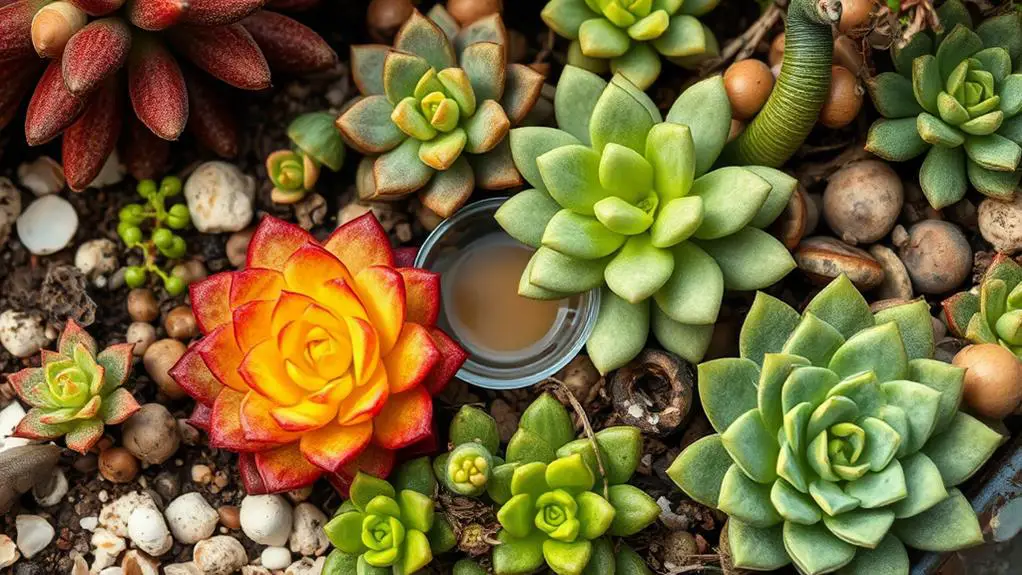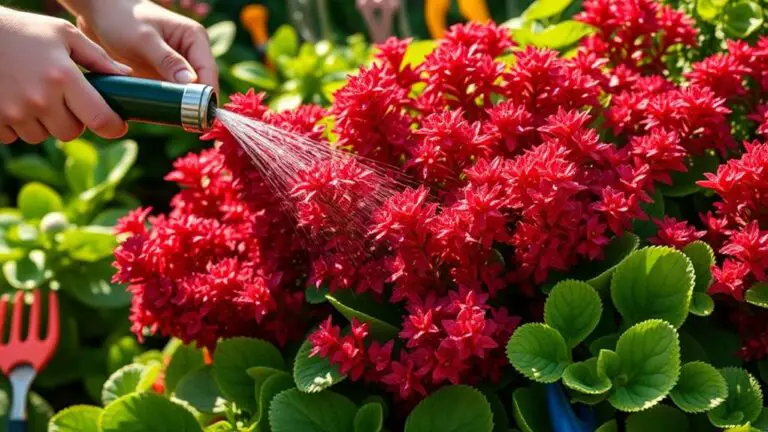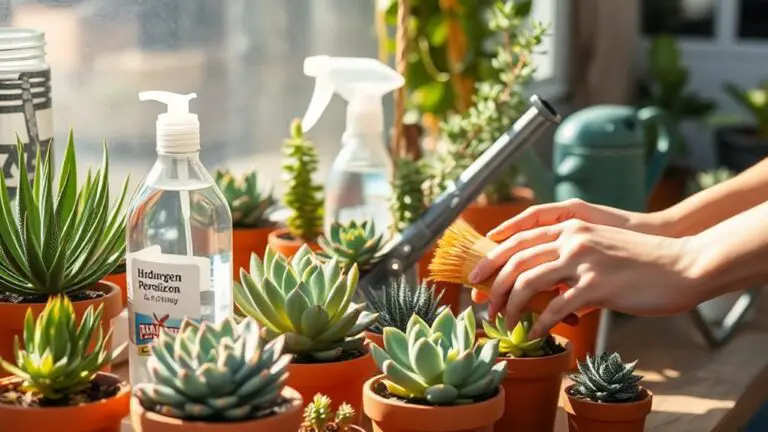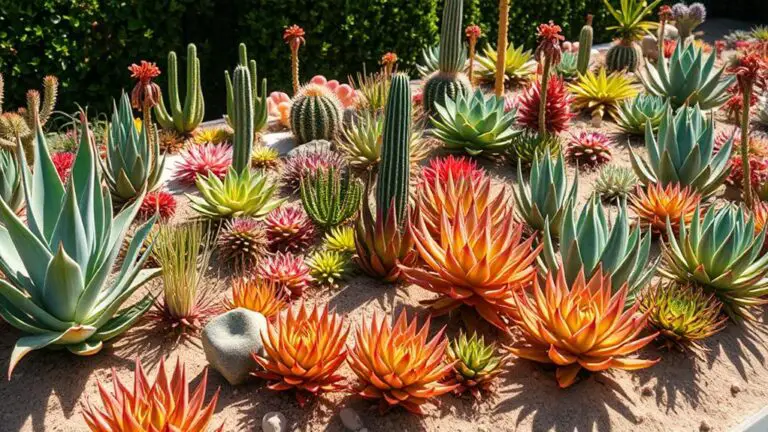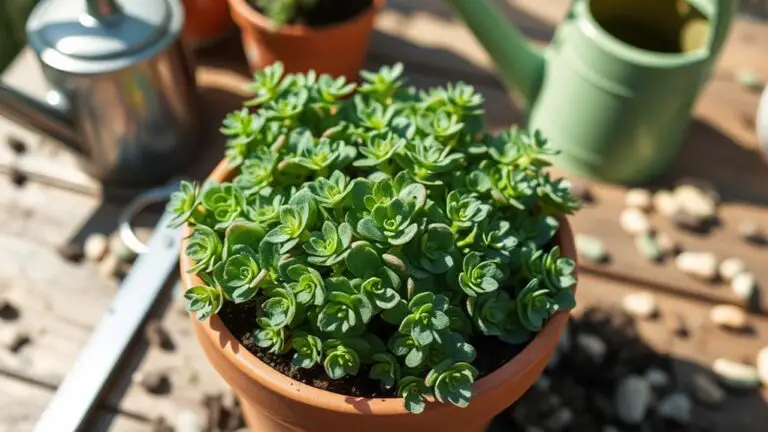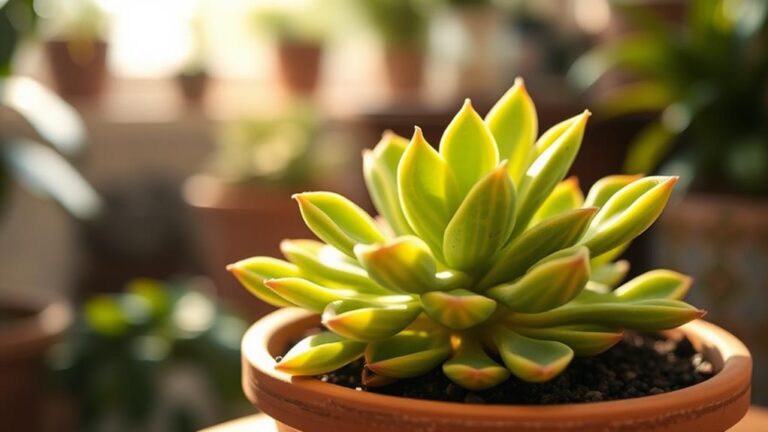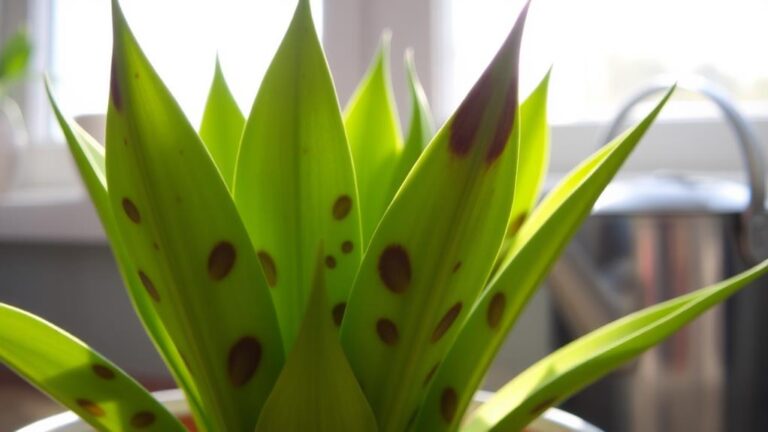How to Get Rid of Slugs and Snails From Your Succulents
When you notice slugs and snails feasting on your beloved succulents, it can be disheartening, but there are practical steps you can take to protect them. By implementing natural deterrents, like crushed eggshells or diatomaceous earth, you create a barrier that these pests find hard to navigate. Adding repellent plants such as garlic or mint nearby can further discourage them. But that's just the beginning of an integrated approach to keeping your succulents safe. Have you considered enlisting the help of natural predators or setting up traps? Let's explore effective strategies to keep your plants thriving.
Natural Deterrents

Ever wondered how to protect your succulents from pesky slugs and snails using natural methods? There are several effective ways to create barriers that keep these pests away without harming the environment.
First, try sprinkling crushed eggshells around the base of your succulents. The sharp edges deter slugs and snails, and as the eggshells break down, they enrich the soil with valuable nutrients.
Coffee grounds can also help. Their bitter taste repels slugs and snails, but make sure your pets don't eat them, as they can be harmful.
Another great option is using copper tape. Wrap it around your pots or place copper screens in the soil. When slugs and snails come into contact with copper, it disrupts their nervous systems, effectively keeping them away.
Diatomaceous earth is another fantastic choice. It creates a rough texture that physically damages the pests, forming a protective barrier around your plants.
Lastly, consider wool pellets. They absorb moisture and slime, making the area unwelcoming for slugs and snails, while also providing nutrients to the soil.
Repellent Plants
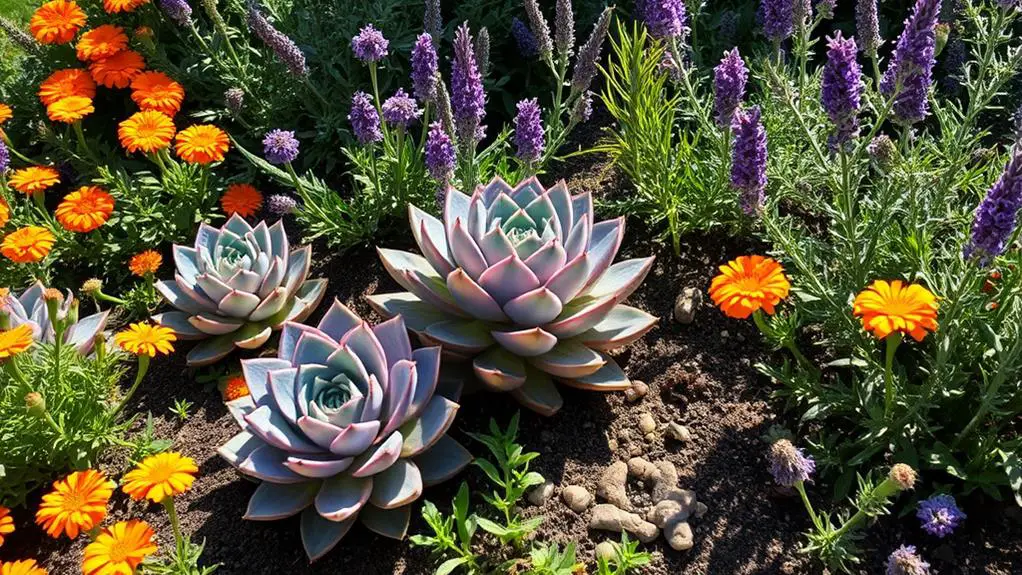
To keep slugs and snails away from your succulents, try planting some repellent plants.
Garlic, chives, and geraniums emit strong scents that slugs and snails dislike, while foxgloves and aromatic plants like fennel and mint create natural barriers.
Effective Repellent Plant Varieties
When looking to protect your succulents from slugs and snails, utilizing repellent plant varieties can be incredibly effective. These plants create a natural barrier that helps deter these pests. For instance, mint is a great choice. Its strong fragrance keeps slugs and snails away, making it a beneficial companion plant for your succulents.
Another effective option is planting members of the allium family, such as garlic and chives. These plants emit strong scents that slugs and snails find unappealing, helping to protect your succulents from these persistent pests.
Foxgloves are also highly effective. They contain toxic properties that naturally deter slugs and snails, ensuring your garden remains pest-free.
Fennel is another plant to take into account. Its aromatic qualities make it unappealing to slugs and snails, providing an additional natural barrier.
Aromatic Plants for Deterrence
While protecting your succulents from slugs and snails, aromatic plants can serve as a powerful deterrent. Garlic and chives from the Allium family are excellent choices. They emit a strong scent that slugs and snails find repulsive, making them perfect companions for your succulent garden. You can plant these aromatic plants around your succulents to create a natural barrier.
Fennel is another great option. Its distinct aroma is unappealing to slugs and snails, helping to keep your succulents safe from infestations.
Mint varieties are also effective. Their potent smell can deter these pests, adding an extra layer of protection for your succulent garden.
Consider adding foxgloves to your garden as well. Not only do they've toxic properties that repel slugs and snails, but they also introduce beautiful flowers to your succulent arrangements.
Combining Plants for Defense
Combining repellent plants is a strategic way to safeguard your succulents from slugs and snails. By using companion planting, you can create a natural barrier that deters these pests.
Start by incorporating members of the Allium family, like garlic and chives. These plants release a strong scent that slugs and snails find unappealing.
Adding mint varieties to your garden also helps. Mint not only adds flavor but its strong aroma effectively keeps slugs and snails at bay.
Consider planting foxgloves. These beautiful plants are toxic to slugs and snails, making them an excellent choice for snail control.
Fennel is another great option. Its aromatic leaves create an environment that slugs and snails don't like.
Natural Predators

Introducing natural predators into your garden can be a highly effective strategy for controlling slug and snail populations around your succulents. These natural predators include frogs, toads, certain bird species, and even hedgehogs. They feed on slugs and snails, helping to keep their numbers in check.
By incorporating these beneficial insects and animals, you're using one of the best slug control methods available, which also contributes to overall garden health.
Ducks are particularly efficient at consuming large quantities of slugs and snails. If you have a spacious outdoor area, consider adding a few ducks to your garden. Their appetite for these pests will greatly reduce the population.
Similarly, hedgehogs are known for their slug and snail diet. Encouraging hedgehogs by creating a safe environment can be another great option.
Creating water sources like small ponds or birdbaths will attract these natural predators. This not only helps with slug control but also supports a diverse ecosystem.
Maintaining a variety of native plants will attract more wildlife, which can help manage slug and snail populations naturally.
With these natural allies, your succulents will thrive in a healthier garden environment.
Traps and Baits
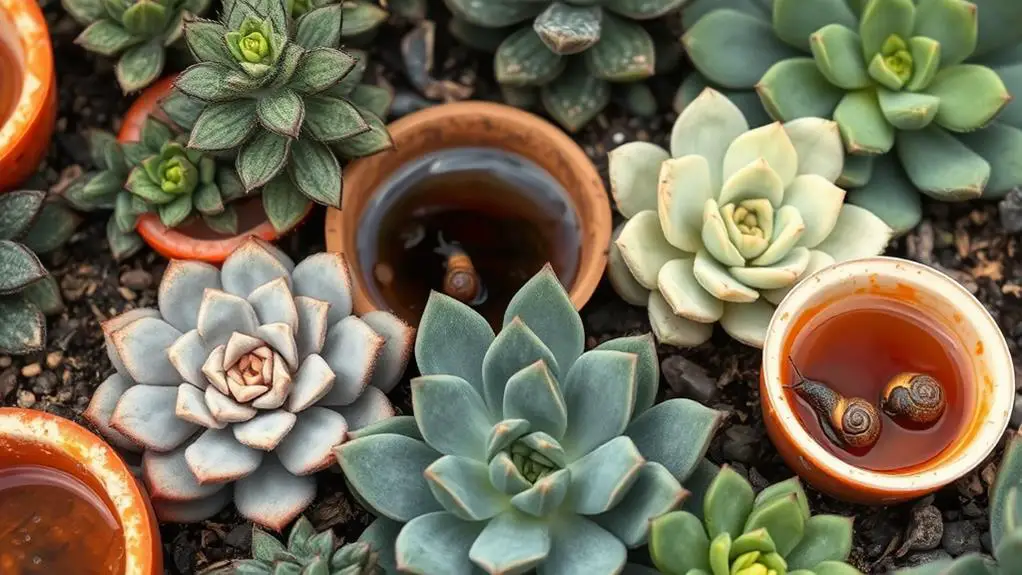
When it comes to trapping and baiting slugs and snails, you've got a few effective options.
Try beer traps by burying shallow bowls of beer in your garden; slugs are drawn to the smell and will drown.
Alternatively, you can mix yeast, flour, sugar, and water to make a homemade bait or use iron phosphate pellets that are safe for your plants but harmful to slugs.
Beer and Yeast Traps
Beer and yeast traps offer a practical and efficient method for ridding your succulents of slugs and snails. To create a beer trap, fill shallow containers with beer and bury them in the soil, guaranteeing the rim is level with the ground. This allows the slimy creatures easy access.
As an alternative, you can mix yeast, flour, sugar, and water to make a natural slug and snail bait. This DIY option is cost-effective and eco-friendly.
For best results, place several traps around your garden, especially near your succulents. Regularly check and refill the traps as they can quickly empty, especially after rain or heavy dew. Promptly disposing of captured slugs and snails will keep them from returning and guarantee ongoing protection for your plants.
Here's a quick guide to help you:
- Set Up: Bury shallow containers of beer or a yeast mixture with the rim level to the ground.
- Maintenance: Regularly check and refill traps, particularly after rain.
- Dispose: Promptly remove trapped slugs and snails to prevent them from coming back.
Using these methods, you'll find beer and yeast traps a reliable way to protect your succulents from these pesky pests.
Iron Phosphate Pellets
Iron phosphate pellets offer an effective and non-toxic solution for gardeners grappling with slug and snail infestations.
These pellets work by disrupting the pests' calcium metabolism, ultimately helping to protect plants from damage. As a bonus, once the pellets break down, they turn into nutrients that benefit your succulents and other plants.
To use iron phosphate pellets, follow the manufacturer's instructions closely. You'll usually need to sprinkle them around the base of affected plants and in areas where you've noticed high slug and snail activity.
This method guarantees that the pests come into contact with the bait as they move around your garden.
One of the great things about iron phosphate is that it's a non-toxic bait, making it safe for use around pets and wildlife.
This eco-friendly control method appeals to gardeners who are environmentally conscious and want to avoid harsh chemicals.
Infestation Signs
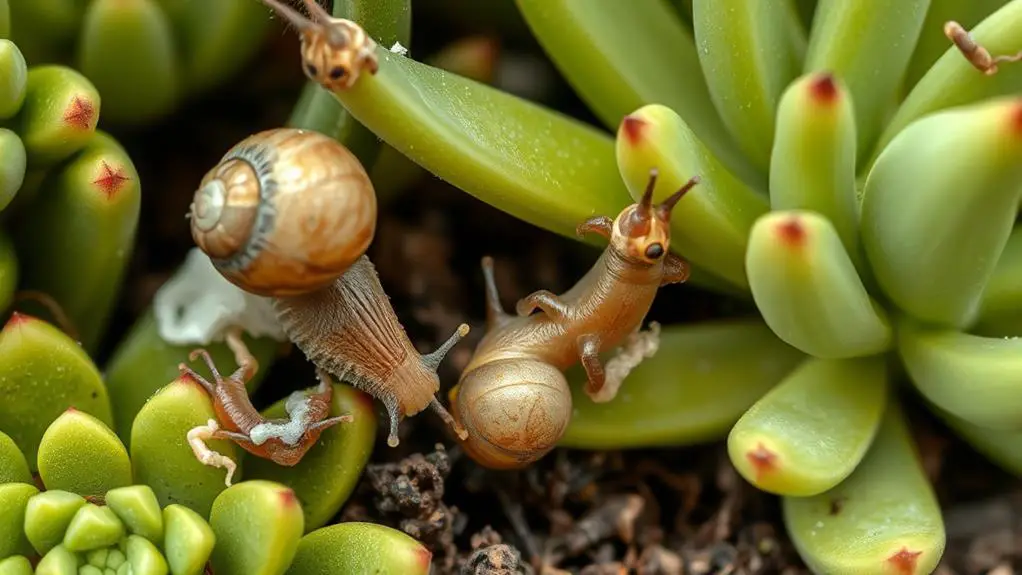
To determine if your succulents are under attack by slugs and snails, look for holes or irregular patterns on the leaves. These feeding marks are classic infestation signs that your plants are being nibbled on.
Another clear indicator is a slime trail. These shiny trails on the soil or plants show slug and snail activity, especially after damp conditions.
If you notice wilted or drooping leaves, it could be due to pest feeding or related environmental stress. Keep an eye out for clusters of eggs near the bases of your plants. These eggs hint at a growing population of pests that could soon cause more damage.
Decreased plant health, such as stunted growth or yellowing leaves, often results from prolonged slug and snail feeding.
Here are three signs to check for:
- Holes or irregular leaf patterns – Look closely at your succulent leaves.
- Slime trails – Check the soil and leaves for these shiny trails.
- Clusters of eggs – Inspect the base of plants for small, clear eggs.
Spotting these early signs can help you protect your succulents and keep them healthy. By staying vigilant, you'll be better prepared to tackle these pesky invaders.
Effective Elimination Methods
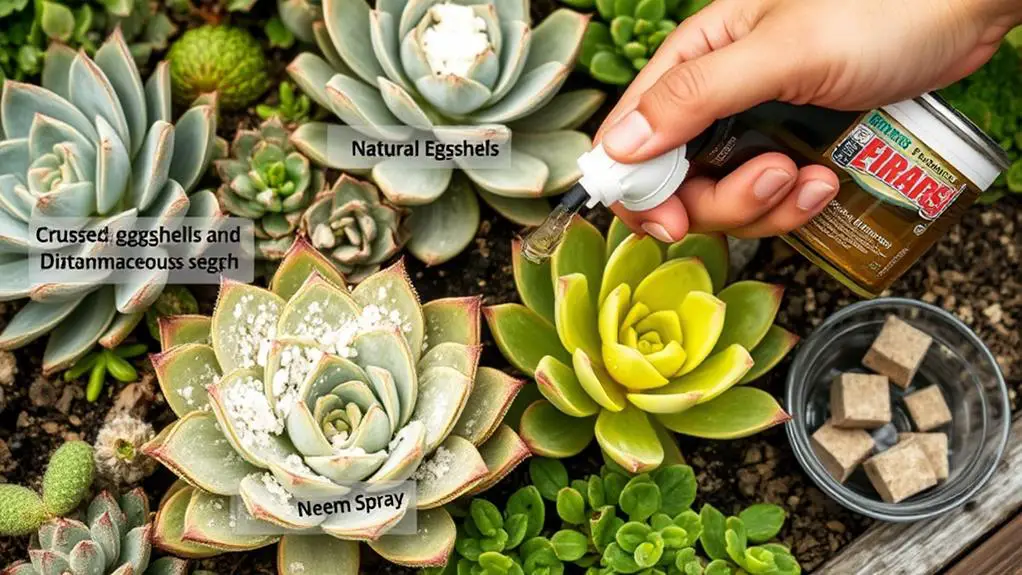
Once you've identified the telltale signs of slug and snail infestations on your succulents, it's time to take action. Start by hand-picking slugs and snails at night when they're most active. This method allows for immediate removal and helps you see exactly where they're hiding.
Another effective method is beer traps. Bury shallow bowls filled with beer in the ground. Slugs are attracted to the beer, fall in, and drown. You'll need to check and refill these traps regularly for the best results.
To create a barrier, you can use crushed eggshells around your plants. The sharp edges deter slugs and also improve soil health as they decompose. Spraying cold coffee on affected areas can repel slugs due to the caffeine content, and coffee grounds around plants create a rough texture that slugs avoid.
For a more targeted approach, consider iron phosphate pellets. These disrupt the calcium metabolism in slugs, effectively controlling the population while being safe for plants and enriching the soil as they break down.
| Method | How It Works | Benefits |
|---|---|---|
| Hand-Picking | Direct removal at night | Immediate results |
| Beer Traps | Attracts and drowns slugs | Easy to set up |
| Eggshell Barrier | Sharp edges deter slugs | Improves soil health |
| Iron Phosphate | Disrupts calcium metabolism in slugs | Safe for plants, enriches soil |
Favorite Succulent Varieties
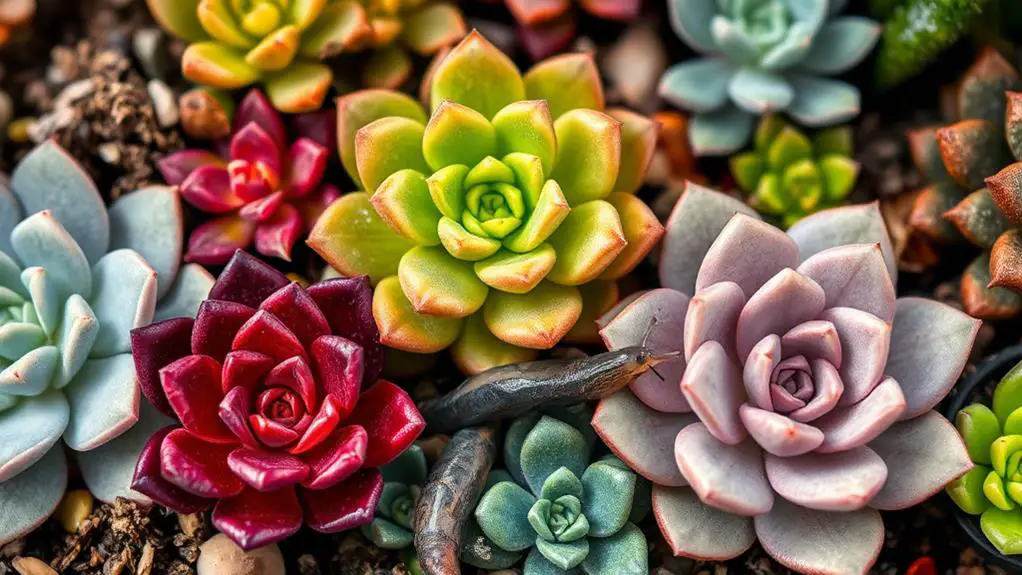
When choosing succulents for your garden, it's essential to be aware of the varieties that slugs and snails find particularly tempting. These slimy pests can cause significant damage if you're not careful.
Here are some favorite succulent varieties that slugs and snails love and tips on how to keep them away.
- Cotyledon Pendens: This succulent has soft, fleshy leaves that slugs and snails find irresistible. To protect it, consider using a barrier that snails can't cross, like crushed eggshells or diatomaceous earth.
- Echeveria Laulensis: Known for its tender rosette shape, this variety is a common target. Keep an eye on the soil quality and make sure it's well-draining to avoid creating a damp environment that attracts these pests.
- Sedum Morganianum: The succulent leaf structure of various Sedum species, including Sedum morganianum, makes them favorites of slugs and snails. Regularly check for these pests and remove them by hand if spotted.
Frequently Asked Questions
How to Get Rid of Slugs on Succulents?
You can get rid of slugs on succulents by hand-picking them at night, setting up beer traps, creating barriers with crushed eggshells or copper tape, maintaining a clean garden, and introducing natural predators like birds or frogs.
Do Slugs and Snails Eat Succulents?
Yes, slugs and snails do eat succulents. They're attracted to the juicy, fleshy leaves, often feeding at night or in damp conditions. Their feeding habits can cause significant damage and even transmit plant diseases.
How Can I Stop Slugs and Snails Eating My Plants?
To stop slugs and snails from eating your plants, create barriers with crushed eggshells, plant garlic and mint, use coffee grounds, set beer traps, and keep your garden tidy by removing debris and excess moisture.
Does Vinegar Kill Slugs and Snails?
Yes, vinegar kills slugs and snails. Spray a 50% vinegar and water solution directly on them. Be careful, though; it can harm your plants if used too much or undiluted. It's not a permanent solution.
Conclusion
By using natural deterrents, repellent plants, and traps, you can keep slugs and snails away from your succulents. Don't forget to attract natural predators like frogs and birds to help out. Regularly check your plants for any signs of infestation and act quickly if you spot any. With these steps, your succulents will stay healthy and vibrant. You've got this—happy gardening!

